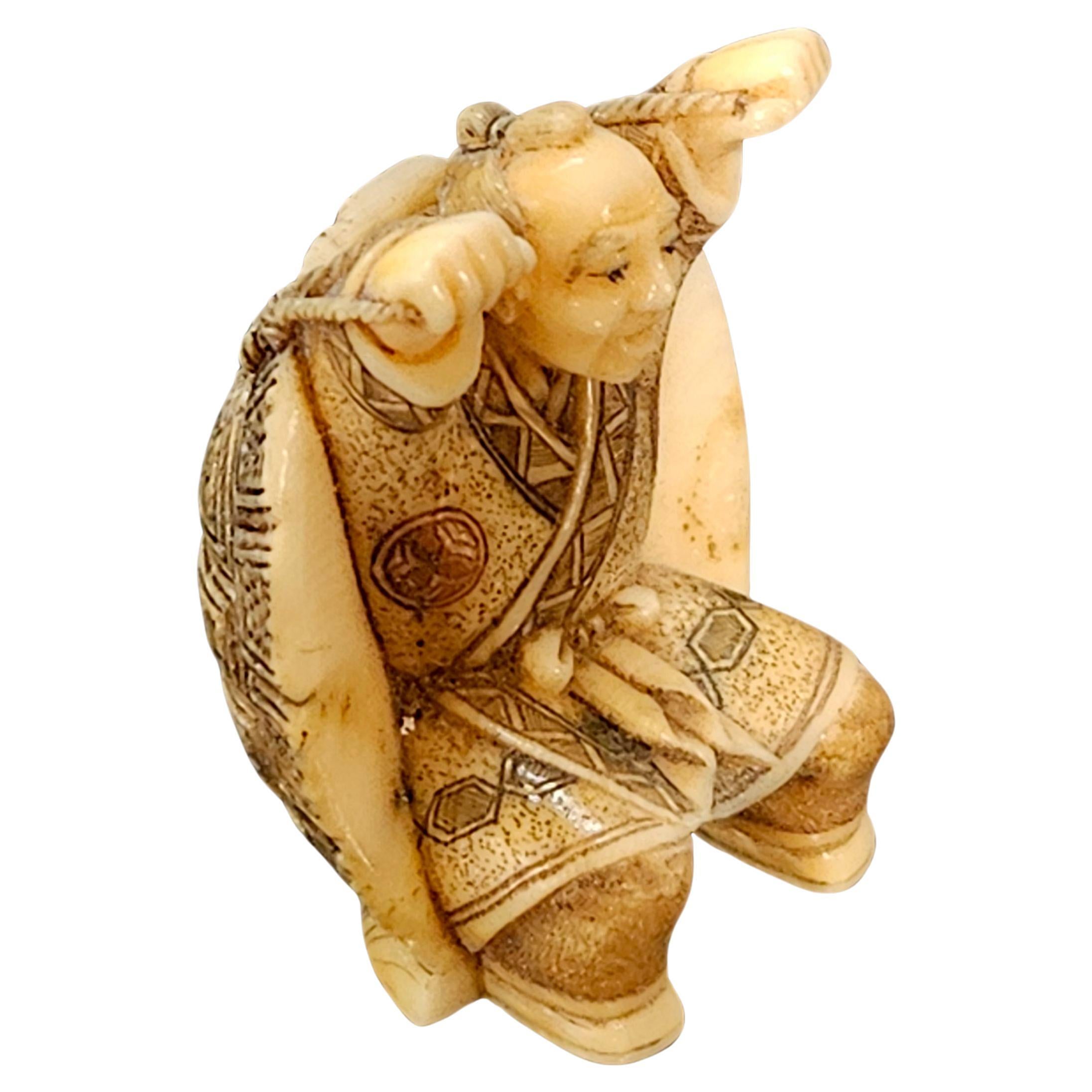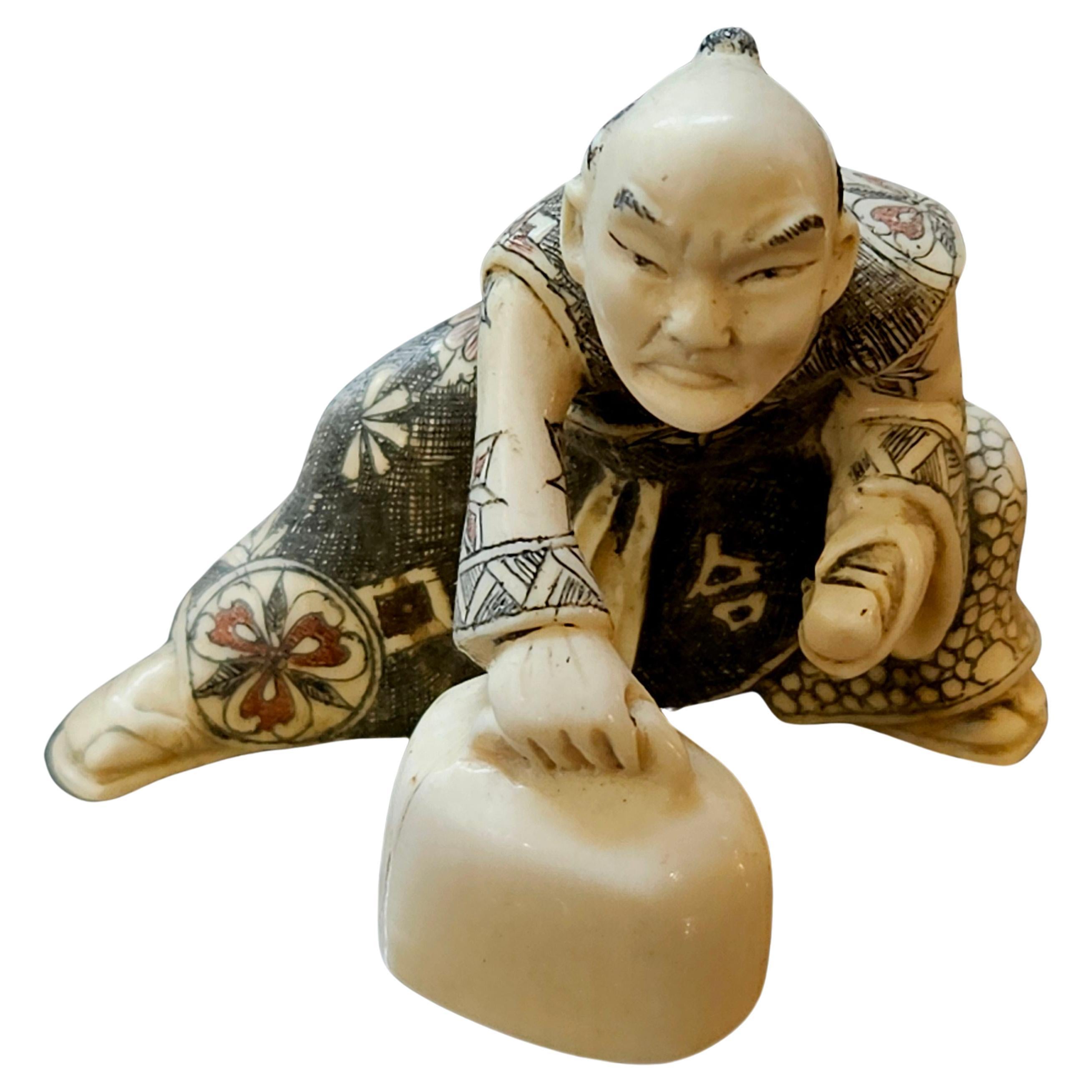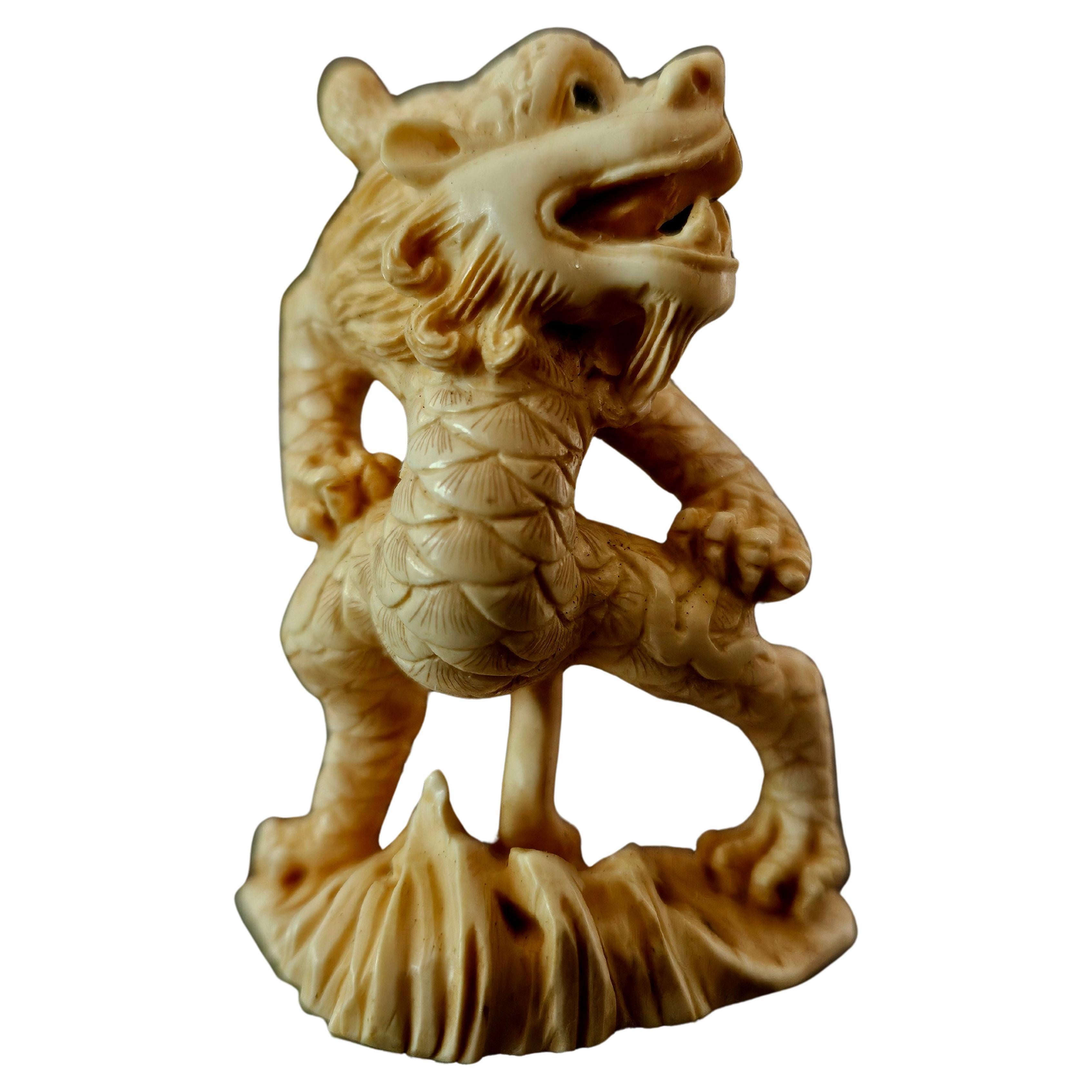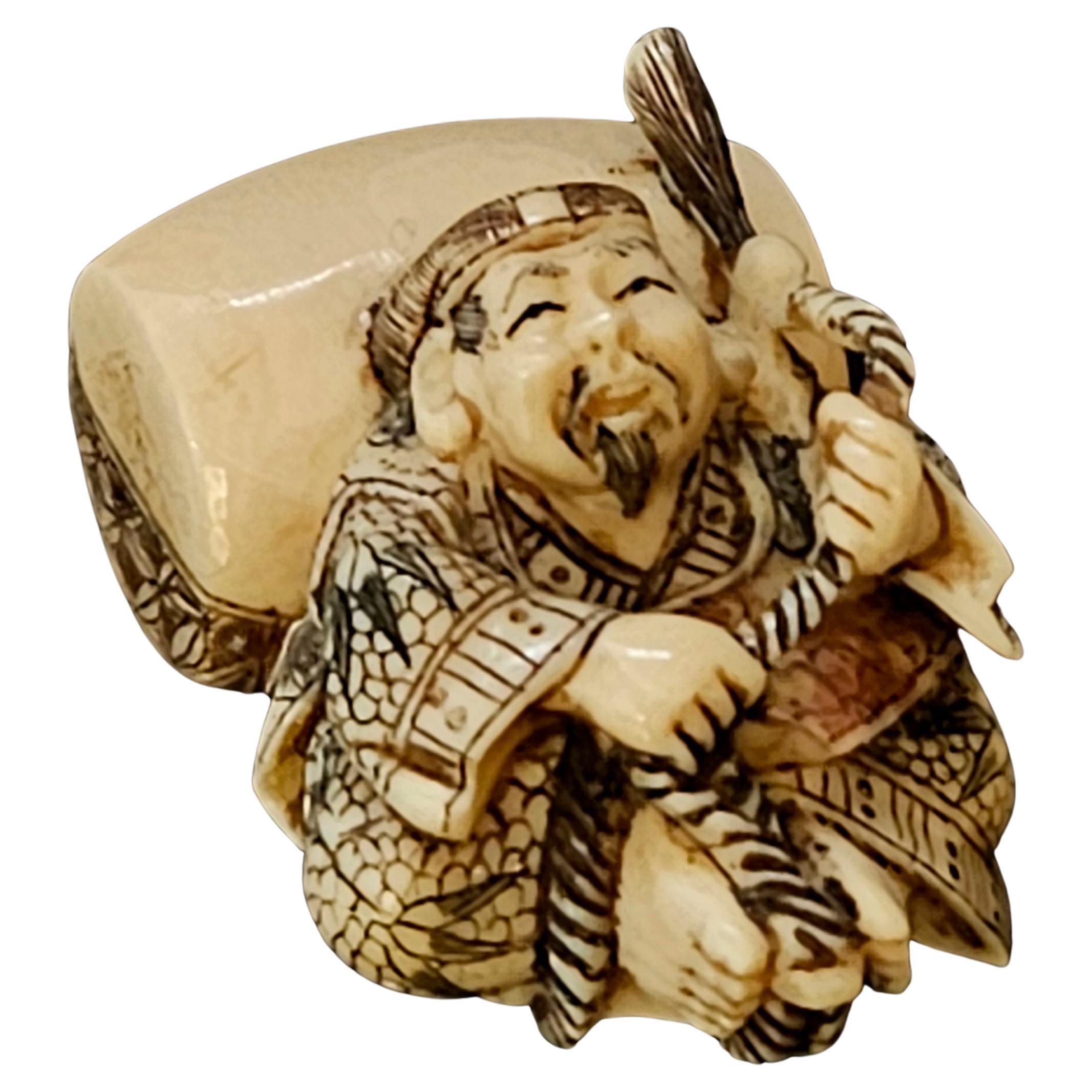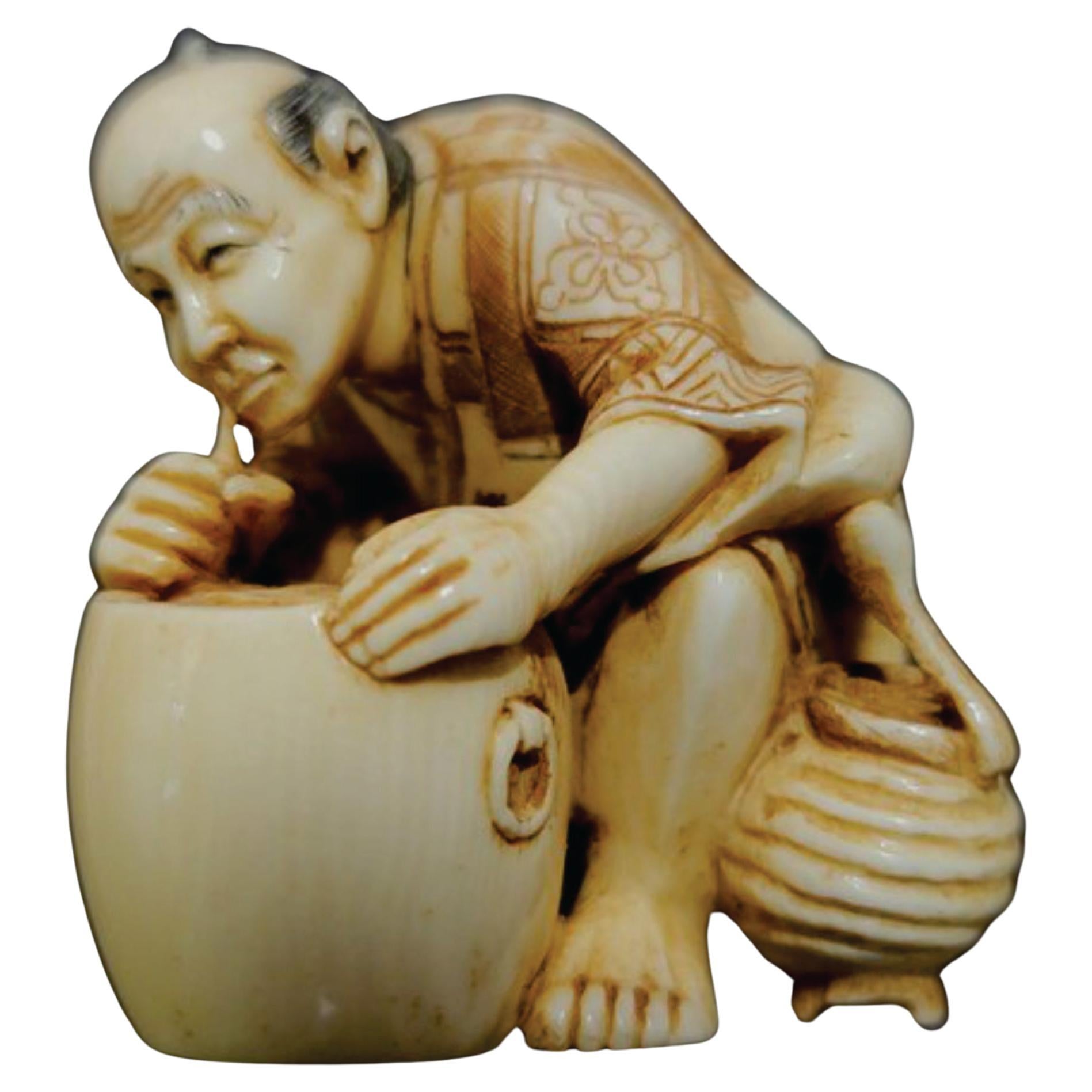Items Similar to Japanese Carved Netsuke A Goose Biting a Fish-Signed by Tomotada, Edo
Want more images or videos?
Request additional images or videos from the seller
1 of 12
Japanese Carved Netsuke A Goose Biting a Fish-Signed by Tomotada, Edo
About the Item
Netsuke Japanese Hand-Carved Mixed Material Figure, A Goose Biting a Fish-Signed by Tomotada from the Edo period. Ric.NA007
This item is 2" wide x 1" deep x 0.75" high in dimension, from the late 19th century.
This item is in excellent condition with no damages.
Shipping Note: USA only, no International shipping
The Essence of Netsuke:
Like all art objects of great worth, netsuke distills the essence of a specific time and place. Worn as part of a traditional Japanese man’s ensemble from the 17th century onwards, the netsuke’s purpose was hyper-specific, and its functional simplicity lent artists unlimited freedom to constantly redefine what it could be.
Formally, netsukes have few requirements: they must be small, they must have holes through which to pass a single cord, and they must have no protuberances that could damage one’s kimono. Everything else is left to the carver’s imagination. As such netsuke differs in style, subject, and material as widely as the personalities of their makers, and they are consequently supremely collectible.
Netsuke emerged as a practical solution to dressing in 17th-century Japan. ‘Men’s kimonos didn’t have sewn-up sleeves — they were completely open, front and back, and that meant that the sleeves couldn’t be used as a pocket, as they could in women’s kimonos,’ Goodall explains. To carry things such as tobacco, medicine, or other necessities, men hung stylish inro and other vessels from cords looped under and behind the wide sashes that held their kimonos in place. At the other end of those cords, men fastened small, ornamental objects as counterweights; those objects evolved into netsuke.
The netsuke’s origins are still ‘theoretical’, Goodall says. ‘It’s thought that, with increasing imports from China in the late 17th and early 18th centuries, the toggles that were used on Chinese clothing were imported,’ she explains. Those toggles may have spawned the netsuke.
But the netsuke we know today is a distinctly Japanese art form. ‘As the form developed, and as the netsuke carvers began to compete with each other to come up with new and different ways of handling netsuke, then it became a localized art form that did not relate to anything in China,’ Goodall says. ‘It had completed its evolution by the 19th century.’
Much like jewelry, watches, and handbags today, netsuke were worn to match different occasions and ensembles. Japanese men who could afford them amassed netsuke to diversify their wardrobes.
Still, as Japanese fashion became more influenced by the West, netsuke disappeared from everyday use. Westerners took up the collector’s mantle. ‘In the Meiji period, right after Japan opened to the West in 1854, Americans and Europeans discovered netsuke and immediately started collecting them,’ Goodall says. ‘Westerners were so intrigued by netsuke that carvers continued to make a living by selling them to Westerners.’
- Dimensions:Height: 0.75 in (1.91 cm)Width: 2 in (5.08 cm)Depth: 1 in (2.54 cm)
- Materials and Techniques:
- Place of Origin:
- Period:
- Date of Manufacture:19th Century
- Condition:Wear consistent with age and use. Wear consistent with age and use.
- Seller Location:Norton, MA
- Reference Number:1stDibs: LU5848239468082
About the Seller
5.0
Platinum Seller
These expertly vetted sellers are 1stDibs' most experienced sellers and are rated highest by our customers.
Established in 2000
1stDibs seller since 2021
88 sales on 1stDibs
Typical response time: 1 hour
- ShippingRetrieving quote...Ships From: Norton, MA
- Return PolicyA return for this item may be initiated within 3 days of delivery.
More From This SellerView All
- Japanese Carved Netsuke Polychrome Figure Group"The Turtleman" Signed , EdoLocated in Norton, MANetsuke Japanese Hand-Carved Polychrome Figure Group depicts a man carrying a title shell, signed on the bottom from the Edo Period. A truly hand-carved ivory figure with fine craftsmanship in a detailed carving This item is 1.25" wide x1.125" deep x 1.5" high in dimension, from the 19th century. This item is in excellent condition with no damages. Shipping Note: USA only, no International shipping The Essence of Netsuke: Like all art objects of great worth, netsuke distills the essence of a specific time and place. Worn as part of a traditional Japanese man’s ensemble from the 17th century onwards, the netsuke’s purpose was hyper-specific, and its functional simplicity lent artists unlimited freedom to constantly redefine what it could be. Formally, netsukes have few requirements: they must be small, they must have holes through which to pass a single cord, and they must have no protuberances that could damage one’s kimono. Everything else is left to the carver’s imagination. As such netsuke differs in style, subject, and material as widely as the personalities of their makers, and they are consequently supremely collectible. Netsuke emerged as a practical solution to dressing in 17th-century Japan. ‘Men’s kimonos didn’t have sewn-up sleeves — they were completely open, front and back, and that meant that the sleeves couldn’t be used as a pocket, as they could in women’s kimonos,’ Goodall explains. To carry things such as tobacco, medicine, or other necessities, men hung stylish inro and other vessels from cords looped under and behind the wide sashes that held their kimonos in place. At the other end of those cords, men fastened small, ornamental objects as counterweights; those objects evolved into netsuke. The netsuke’s origins are still ‘theoretical’, Goodall says. ‘It’s thought that, with increasing imports from China in the late 17th and early 18th centuries, the toggles that were used on Chinese...Category
Antique 19th Century Japanese Decorative Boxes
MaterialsIvory, Paint
- Japanese Carved Netsuke Polychrome Figure by Gyokushi (玉芝), Edo PeriodLocated in Norton, MANetsuke Japanese Hand-Carved Polychrome Decorated Figure, Signed by Gyokushi (玉芝), Edo Period. A truly hand-carved ivory figure, A man is lifting a weight. It looks like he is chal...Category
Antique 19th Century Japanese Decorative Boxes
MaterialsIvory, Paint
- Japanese Carved Netsuke Humanoid Dragon by Yamada Hojitsu法實, Edo PeriodLocated in Norton, MAJapanese Carved Netsuke Humanoid Dragon-Signed by Yamada Hojitsu法實, Edo Period (1825–1872), Ric.NA001 This item is 1.5" wide x 0.75" deep x 2" high in dimension. This item is in ex...Category
Antique 19th Century Japanese Decorative Boxes
MaterialsIvory, Paint
- Japanese Carved Netsuke Polychrome Decorated Figur, Signed by Matsuyoshi, MeijiLocated in Norton, MANetsuke Japanese Hand-Carved Polychrome Decorated Figure, Signed by Matsuyoshi, from the Meiji period. Ric.NA003 A truly hand-carved mixed material figure, A Wise Man Holding a Rope,...Category
Antique 19th Century Japanese Decorative Boxes
MaterialsIvory, Paint
- Japanese Carved Netsuke Polychrome Decorated Figure, Signed by Yoshitomo, MeijiLocated in Norton, MANetsuke Japanese Hand-Carved Polychrome Decorated Figure, Signed by Yoshitomo from the Meiji period. Ric.NA004 A truly hand-carved ivory figure, An old man holding a straw and soaki...Category
Antique 19th Century Japanese Decorative Boxes
MaterialsIvory, Paint
- Japanese Carved Netsuke Polychrome Figure "Sumo" Signed, Meiji PeriodLocated in Norton, MANetsuke Japanese Hand-Carved Polychrome Decorated Figure "Sumo", depicting a strongman holding a big rope and pulling something, signed on the bottom from the Meiji period. This it...Category
Antique 19th Century Japanese Decorative Boxes
MaterialsIvory, Paint
You May Also Like
- Box Wood Netsuke Turtle Mushroom Japanese Japan Signed, 20th CenturyLocated in Amsterdam, Noord HollandLovely and very detailed piece. Signed. Japan 19th or 20th century. Additional information: Material: Porcelain & Pottery Type: Incense Burners, Koro Region of Origin: Japan Period:...Category
20th Century Japanese Decorative Boxes
MaterialsPorcelain
- Japanese Inro by Koma Koryu Edo PeriodLocated in Atlanta, GAA four-case lacquered inro by Koma Koryu circa 19th century late Edo period. The inro features a pair of Chinese mandarin duck resting under a bundle of blooming irises on the pond. ...Category
Antique 19th Century Japanese Japonisme Lacquer
MaterialsWood, Lacquer
- Antique Japanese Inro by Shigehide Edo PeriodLocated in Atlanta, GAThis exquisite four-case lacquered inro was dated to the latter part of 18th century to early 19th century (Edo period) and made by Shigehide. The opposite sides of the inro together features a lavish flower arrangement in a bamboo basket (ikebana). The detailed craftmanship was a true pleasure to behold. Mostly Takamaki-e (high relief) were used to texturize the delicate petals of the chrysanthemums, on which different shades of gold were used to create contrast. Raden (mother of pearl) shells were also used to highlight some leaves, rendering the piece an interesting balance of color and material. The interior was completed in a mottled gold finish. It was signed Shigehide on the bottom with a Kao. There is a small carved rabbit ojime bead...Category
Antique Late 18th Century Japanese Japonisme Lacquer
MaterialsWood, Lacquer
- Signed Mid 19th C. Edo/Meiji Period Miniature Lacquer Stacking Cabinet, JapanLocated in Oxfordshire, United KingdomThe highly decorated tray in the form of a table frames a series of three stacking boxes, a further three lidded boxes and a tray concealed within, raised on ogee bracket feet. This...Category
Antique 19th Century Japanese Meiji Lacquer
MaterialsLacquer
- Japanese Lacquer Maki-E Scroll Box Fubako by Kansonsai Edo PeriodLocated in Atlanta, GAA Japanese lacquered wood fubako (a box to store document or small scroll painting) circa late 18th century of Edo period. The rectangular box features a deep lid with rounded corners and recessed mid-edge and a lower box with two bronze medallion rings and tasseled silk ties. The surface of the fubako was elaborately decorated with hiramaki-e and a low takamaki-e on a mottled Mura-nashiji background. The motifs on the lid depict branches of Japanese pine with finely rendered needles on the lower part; on the upper part, it showcases fruited persimmon branches. Two different shades of gold fundame were used to contrast the design and augmented by scattered gold kirigane to highlight some of the leaves. The design continues and cascades down to all sides of the lid as well as the walls of the box. The two bronze medallions appear original to the box and the silk ties show significant fading from the age. This Fine fubako is signed on the lower wall "Kanshosai" in Kanji with a kao mark. All the trims were finished in gold fundame and the interiors a dense nashiji in gold. Kanshosai is the mark of the distinguished lacquer artist Lizuka Toyo I who also signed his work "Toyosai". He was active in the second half of the 18th century during Edo period, employed by Hachisuka Shigeyoshi (1738-1801), daimyo of Awa on Shikoku Island. Although most survived work bearing his marks are inros, he was also known to decorated trays and other larger objects...Category
Antique Late 18th Century Japanese Edo Lacquer
MaterialsWood, Lacquer
- Japan, Late 18th Century Gold Lacquer Inro by Kajikawa, Edo PeriodLocated in PARIS, FRLate 18th century Inro by Kajikawa. Edo period Beautiful inro in gold lacquer representing a continuous landscape on both sides. The interior in Nashiji lacquer. Some small traces...Category
Antique 18th Century Japanese Lacquer
MaterialsLacquer
